Mitsubishi: Target Marketing Strategies and Product Management
VerifiedAdded on 2023/04/17
|7
|1140
|498
Report
AI Summary
This report provides a detailed analysis of Mitsubishi's target marketing strategies and product management. It begins by examining how Mitsubishi segments its market, focusing on demographic, psychographic, behavioral, and geographic factors. The report then explores Mitsubishi's targeting strategies, including the selection of specific market segments and the products offered to these segments. Furthermore, the report delves into Mitsubishi's approach to managing its existing products and services, including strategies for maintaining market share and adapting to competition. The report also outlines the steps in Mitsubishi's new product development process, from idea generation and screening to concept development, marketing strategy development, business analysis, and product development. References from various sources such as reports and articles support the analysis, providing a comprehensive understanding of Mitsubishi's marketing and product management practices.

MARKETING & MANAGEMENT
Paraphrase This Document
Need a fresh take? Get an instant paraphrase of this document with our AI Paraphraser
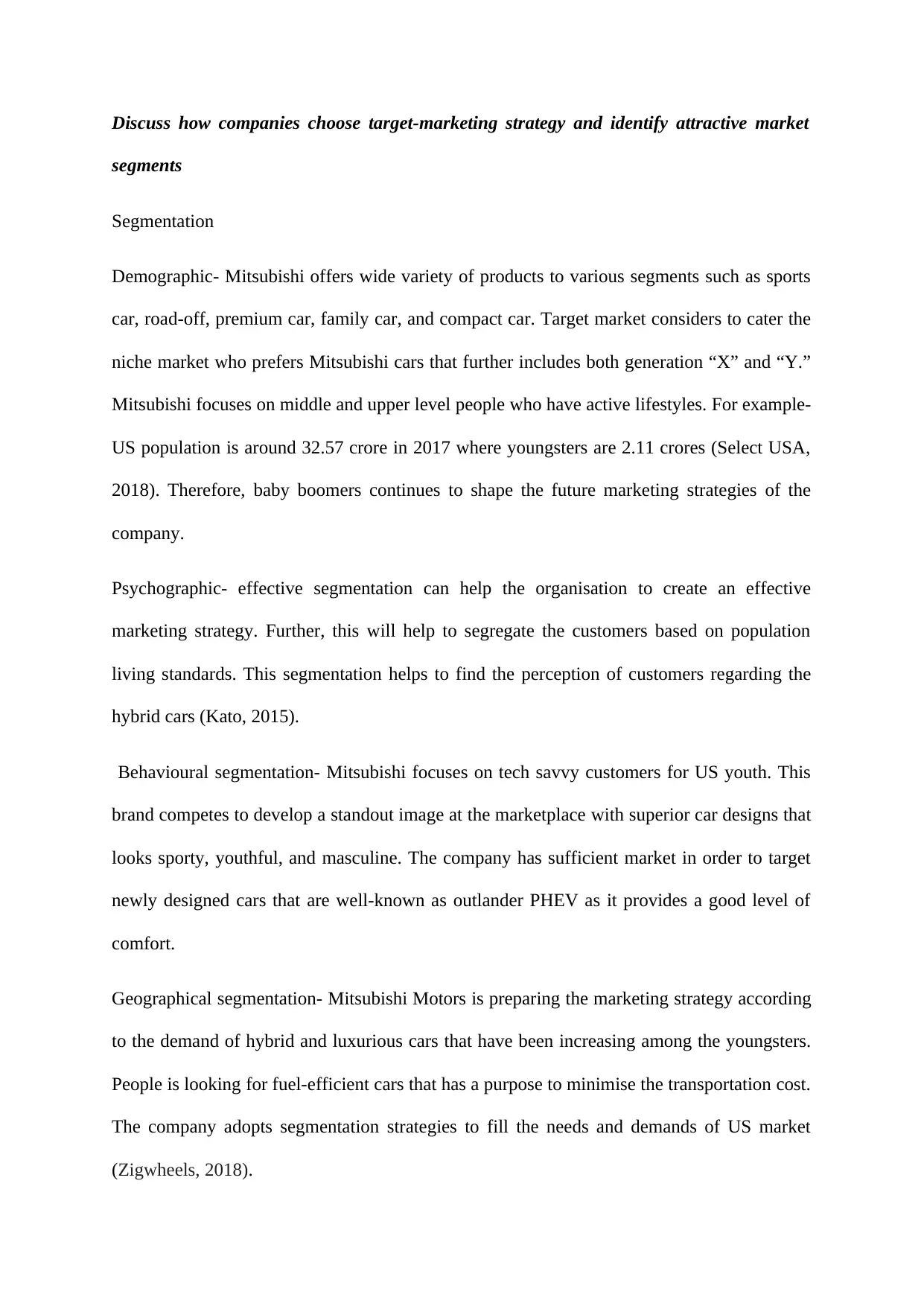
Discuss how companies choose target-marketing strategy and identify attractive market
segments
Segmentation
Demographic- Mitsubishi offers wide variety of products to various segments such as sports
car, road-off, premium car, family car, and compact car. Target market considers to cater the
niche market who prefers Mitsubishi cars that further includes both generation “X” and “Y.”
Mitsubishi focuses on middle and upper level people who have active lifestyles. For example-
US population is around 32.57 crore in 2017 where youngsters are 2.11 crores (Select USA,
2018). Therefore, baby boomers continues to shape the future marketing strategies of the
company.
Psychographic- effective segmentation can help the organisation to create an effective
marketing strategy. Further, this will help to segregate the customers based on population
living standards. This segmentation helps to find the perception of customers regarding the
hybrid cars (Kato, 2015).
Behavioural segmentation- Mitsubishi focuses on tech savvy customers for US youth. This
brand competes to develop a standout image at the marketplace with superior car designs that
looks sporty, youthful, and masculine. The company has sufficient market in order to target
newly designed cars that are well-known as outlander PHEV as it provides a good level of
comfort.
Geographical segmentation- Mitsubishi Motors is preparing the marketing strategy according
to the demand of hybrid and luxurious cars that have been increasing among the youngsters.
People is looking for fuel-efficient cars that has a purpose to minimise the transportation cost.
The company adopts segmentation strategies to fill the needs and demands of US market
(Zigwheels, 2018).
segments
Segmentation
Demographic- Mitsubishi offers wide variety of products to various segments such as sports
car, road-off, premium car, family car, and compact car. Target market considers to cater the
niche market who prefers Mitsubishi cars that further includes both generation “X” and “Y.”
Mitsubishi focuses on middle and upper level people who have active lifestyles. For example-
US population is around 32.57 crore in 2017 where youngsters are 2.11 crores (Select USA,
2018). Therefore, baby boomers continues to shape the future marketing strategies of the
company.
Psychographic- effective segmentation can help the organisation to create an effective
marketing strategy. Further, this will help to segregate the customers based on population
living standards. This segmentation helps to find the perception of customers regarding the
hybrid cars (Kato, 2015).
Behavioural segmentation- Mitsubishi focuses on tech savvy customers for US youth. This
brand competes to develop a standout image at the marketplace with superior car designs that
looks sporty, youthful, and masculine. The company has sufficient market in order to target
newly designed cars that are well-known as outlander PHEV as it provides a good level of
comfort.
Geographical segmentation- Mitsubishi Motors is preparing the marketing strategy according
to the demand of hybrid and luxurious cars that have been increasing among the youngsters.
People is looking for fuel-efficient cars that has a purpose to minimise the transportation cost.
The company adopts segmentation strategies to fill the needs and demands of US market
(Zigwheels, 2018).
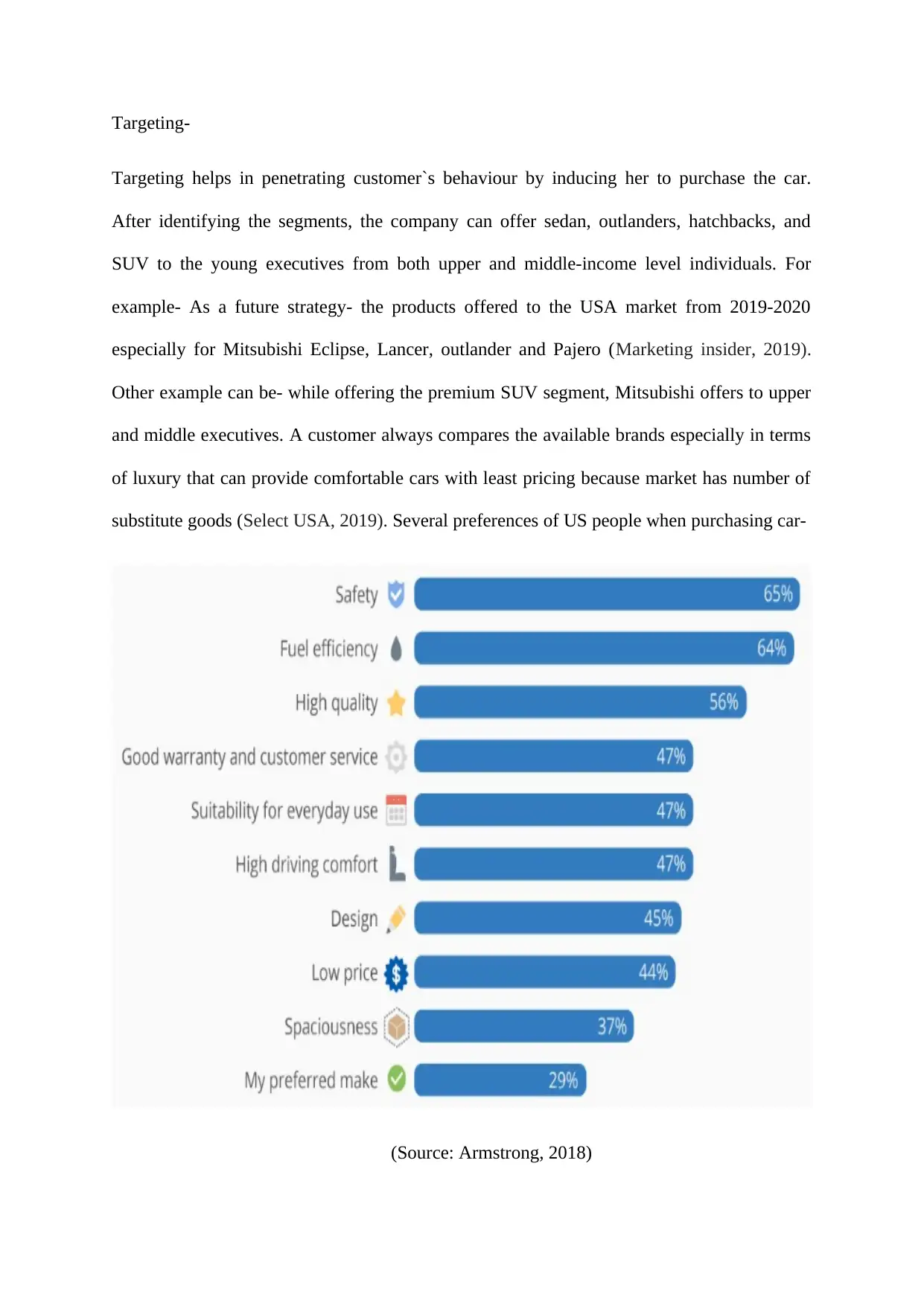
Targeting-
Targeting helps in penetrating customer`s behaviour by inducing her to purchase the car.
After identifying the segments, the company can offer sedan, outlanders, hatchbacks, and
SUV to the young executives from both upper and middle-income level individuals. For
example- As a future strategy- the products offered to the USA market from 2019-2020
especially for Mitsubishi Eclipse, Lancer, outlander and Pajero (Marketing insider, 2019).
Other example can be- while offering the premium SUV segment, Mitsubishi offers to upper
and middle executives. A customer always compares the available brands especially in terms
of luxury that can provide comfortable cars with least pricing because market has number of
substitute goods (Select USA, 2019). Several preferences of US people when purchasing car-
(Source: Armstrong, 2018)
Targeting helps in penetrating customer`s behaviour by inducing her to purchase the car.
After identifying the segments, the company can offer sedan, outlanders, hatchbacks, and
SUV to the young executives from both upper and middle-income level individuals. For
example- As a future strategy- the products offered to the USA market from 2019-2020
especially for Mitsubishi Eclipse, Lancer, outlander and Pajero (Marketing insider, 2019).
Other example can be- while offering the premium SUV segment, Mitsubishi offers to upper
and middle executives. A customer always compares the available brands especially in terms
of luxury that can provide comfortable cars with least pricing because market has number of
substitute goods (Select USA, 2019). Several preferences of US people when purchasing car-
(Source: Armstrong, 2018)
⊘ This is a preview!⊘
Do you want full access?
Subscribe today to unlock all pages.

Trusted by 1+ million students worldwide
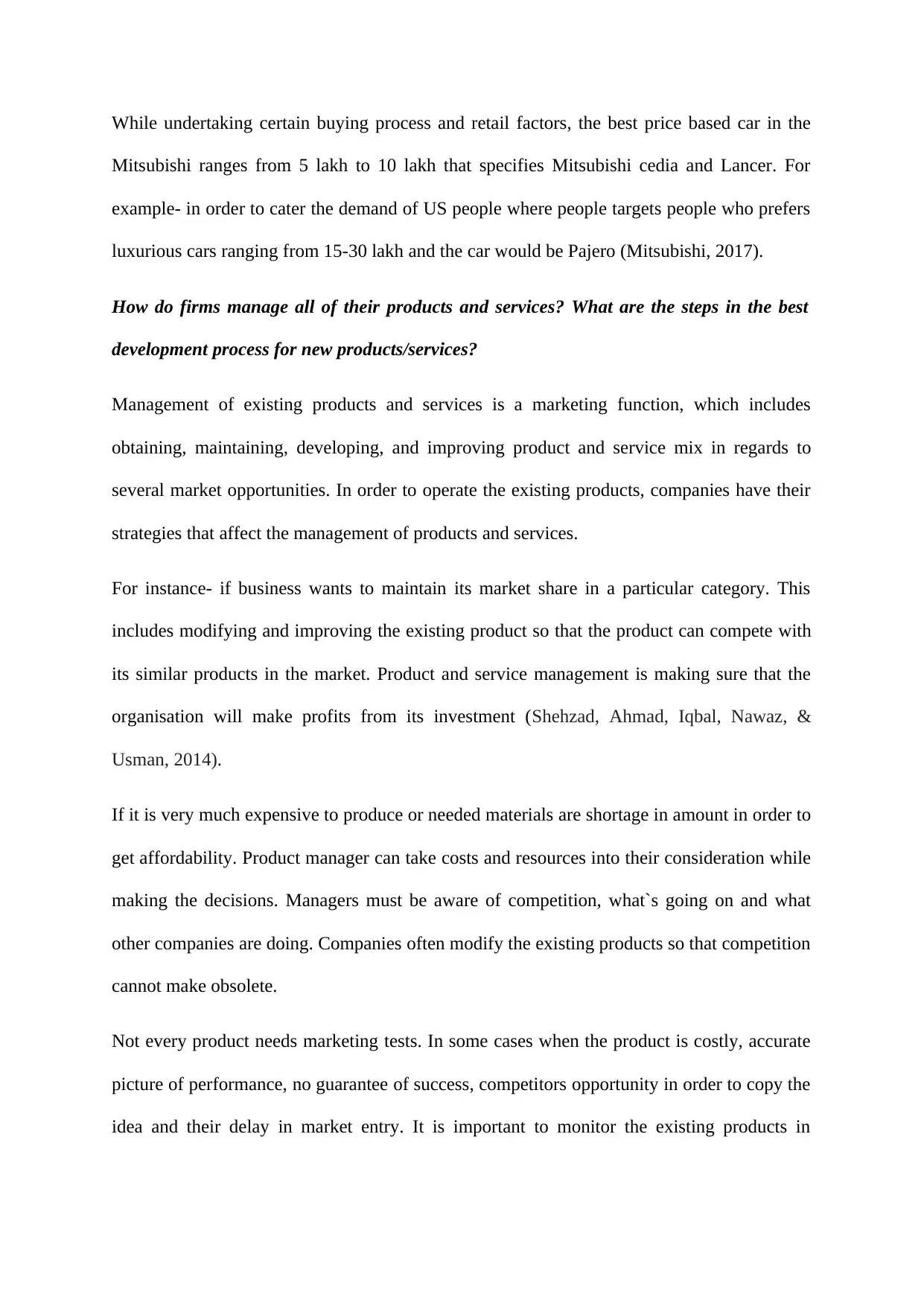
While undertaking certain buying process and retail factors, the best price based car in the
Mitsubishi ranges from 5 lakh to 10 lakh that specifies Mitsubishi cedia and Lancer. For
example- in order to cater the demand of US people where people targets people who prefers
luxurious cars ranging from 15-30 lakh and the car would be Pajero (Mitsubishi, 2017).
How do firms manage all of their products and services? What are the steps in the best
development process for new products/services?
Management of existing products and services is a marketing function, which includes
obtaining, maintaining, developing, and improving product and service mix in regards to
several market opportunities. In order to operate the existing products, companies have their
strategies that affect the management of products and services.
For instance- if business wants to maintain its market share in a particular category. This
includes modifying and improving the existing product so that the product can compete with
its similar products in the market. Product and service management is making sure that the
organisation will make profits from its investment (Shehzad, Ahmad, Iqbal, Nawaz, &
Usman, 2014).
If it is very much expensive to produce or needed materials are shortage in amount in order to
get affordability. Product manager can take costs and resources into their consideration while
making the decisions. Managers must be aware of competition, what`s going on and what
other companies are doing. Companies often modify the existing products so that competition
cannot make obsolete.
Not every product needs marketing tests. In some cases when the product is costly, accurate
picture of performance, no guarantee of success, competitors opportunity in order to copy the
idea and their delay in market entry. It is important to monitor the existing products in
Mitsubishi ranges from 5 lakh to 10 lakh that specifies Mitsubishi cedia and Lancer. For
example- in order to cater the demand of US people where people targets people who prefers
luxurious cars ranging from 15-30 lakh and the car would be Pajero (Mitsubishi, 2017).
How do firms manage all of their products and services? What are the steps in the best
development process for new products/services?
Management of existing products and services is a marketing function, which includes
obtaining, maintaining, developing, and improving product and service mix in regards to
several market opportunities. In order to operate the existing products, companies have their
strategies that affect the management of products and services.
For instance- if business wants to maintain its market share in a particular category. This
includes modifying and improving the existing product so that the product can compete with
its similar products in the market. Product and service management is making sure that the
organisation will make profits from its investment (Shehzad, Ahmad, Iqbal, Nawaz, &
Usman, 2014).
If it is very much expensive to produce or needed materials are shortage in amount in order to
get affordability. Product manager can take costs and resources into their consideration while
making the decisions. Managers must be aware of competition, what`s going on and what
other companies are doing. Companies often modify the existing products so that competition
cannot make obsolete.
Not every product needs marketing tests. In some cases when the product is costly, accurate
picture of performance, no guarantee of success, competitors opportunity in order to copy the
idea and their delay in market entry. It is important to monitor the existing products in
Paraphrase This Document
Need a fresh take? Get an instant paraphrase of this document with our AI Paraphraser
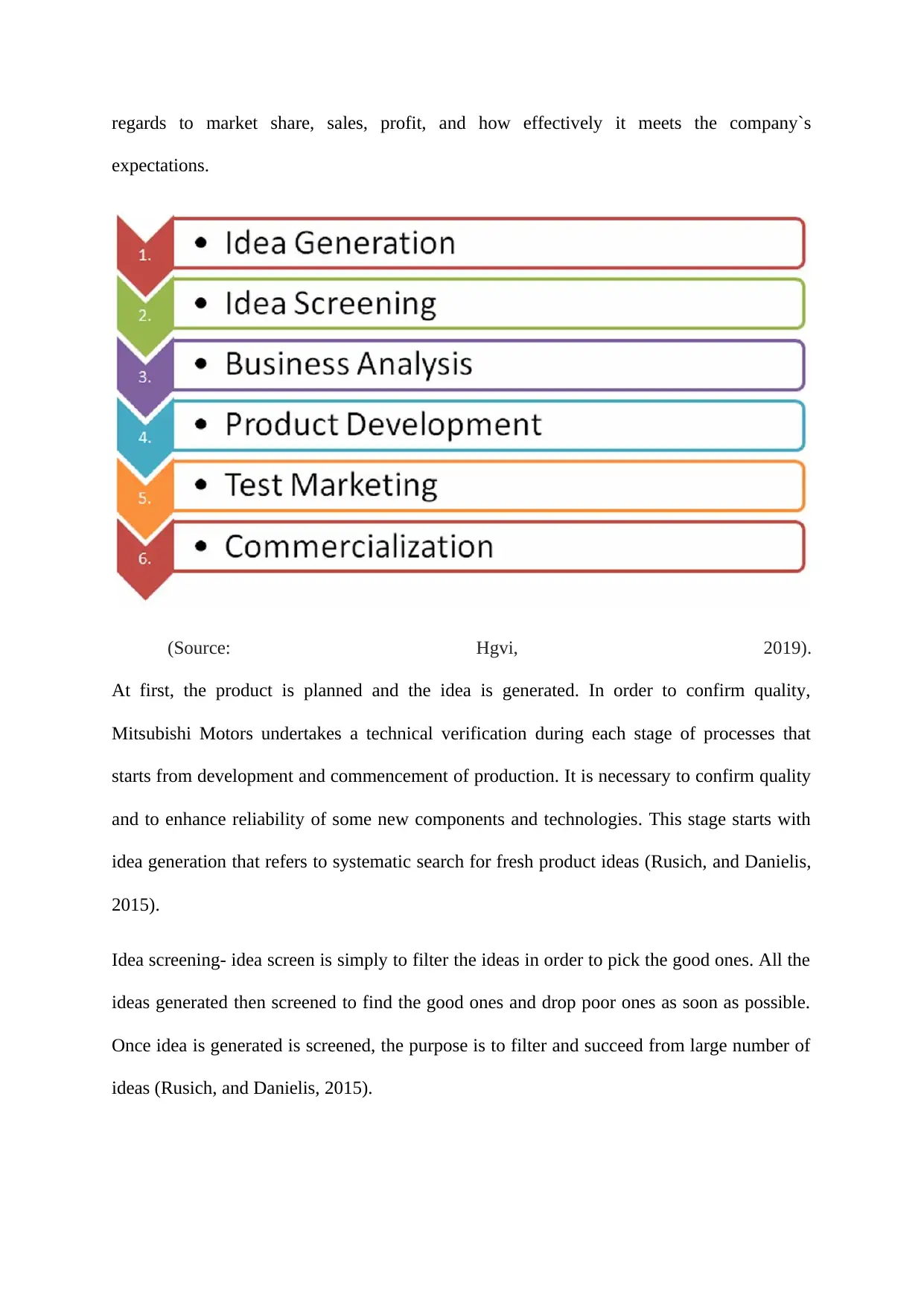
regards to market share, sales, profit, and how effectively it meets the company`s
expectations.
(Source: Hgvi, 2019).
At first, the product is planned and the idea is generated. In order to confirm quality,
Mitsubishi Motors undertakes a technical verification during each stage of processes that
starts from development and commencement of production. It is necessary to confirm quality
and to enhance reliability of some new components and technologies. This stage starts with
idea generation that refers to systematic search for fresh product ideas (Rusich, and Danielis,
2015).
Idea screening- idea screen is simply to filter the ideas in order to pick the good ones. All the
ideas generated then screened to find the good ones and drop poor ones as soon as possible.
Once idea is generated is screened, the purpose is to filter and succeed from large number of
ideas (Rusich, and Danielis, 2015).
expectations.
(Source: Hgvi, 2019).
At first, the product is planned and the idea is generated. In order to confirm quality,
Mitsubishi Motors undertakes a technical verification during each stage of processes that
starts from development and commencement of production. It is necessary to confirm quality
and to enhance reliability of some new components and technologies. This stage starts with
idea generation that refers to systematic search for fresh product ideas (Rusich, and Danielis,
2015).
Idea screening- idea screen is simply to filter the ideas in order to pick the good ones. All the
ideas generated then screened to find the good ones and drop poor ones as soon as possible.
Once idea is generated is screened, the purpose is to filter and succeed from large number of
ideas (Rusich, and Danielis, 2015).
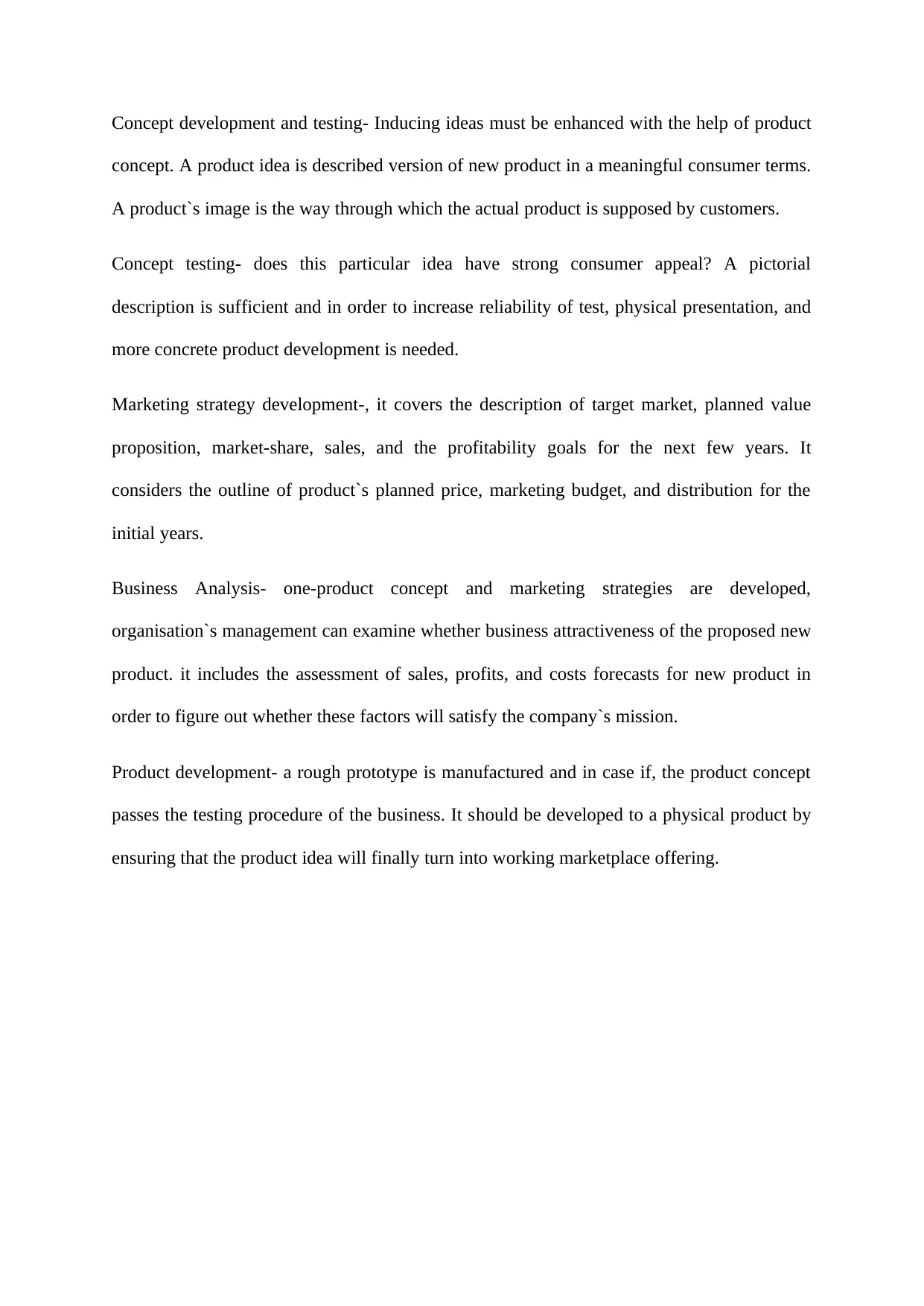
Concept development and testing- Inducing ideas must be enhanced with the help of product
concept. A product idea is described version of new product in a meaningful consumer terms.
A product`s image is the way through which the actual product is supposed by customers.
Concept testing- does this particular idea have strong consumer appeal? A pictorial
description is sufficient and in order to increase reliability of test, physical presentation, and
more concrete product development is needed.
Marketing strategy development-, it covers the description of target market, planned value
proposition, market-share, sales, and the profitability goals for the next few years. It
considers the outline of product`s planned price, marketing budget, and distribution for the
initial years.
Business Analysis- one-product concept and marketing strategies are developed,
organisation`s management can examine whether business attractiveness of the proposed new
product. it includes the assessment of sales, profits, and costs forecasts for new product in
order to figure out whether these factors will satisfy the company`s mission.
Product development- a rough prototype is manufactured and in case if, the product concept
passes the testing procedure of the business. It should be developed to a physical product by
ensuring that the product idea will finally turn into working marketplace offering.
concept. A product idea is described version of new product in a meaningful consumer terms.
A product`s image is the way through which the actual product is supposed by customers.
Concept testing- does this particular idea have strong consumer appeal? A pictorial
description is sufficient and in order to increase reliability of test, physical presentation, and
more concrete product development is needed.
Marketing strategy development-, it covers the description of target market, planned value
proposition, market-share, sales, and the profitability goals for the next few years. It
considers the outline of product`s planned price, marketing budget, and distribution for the
initial years.
Business Analysis- one-product concept and marketing strategies are developed,
organisation`s management can examine whether business attractiveness of the proposed new
product. it includes the assessment of sales, profits, and costs forecasts for new product in
order to figure out whether these factors will satisfy the company`s mission.
Product development- a rough prototype is manufactured and in case if, the product concept
passes the testing procedure of the business. It should be developed to a physical product by
ensuring that the product idea will finally turn into working marketplace offering.
⊘ This is a preview!⊘
Do you want full access?
Subscribe today to unlock all pages.

Trusted by 1+ million students worldwide
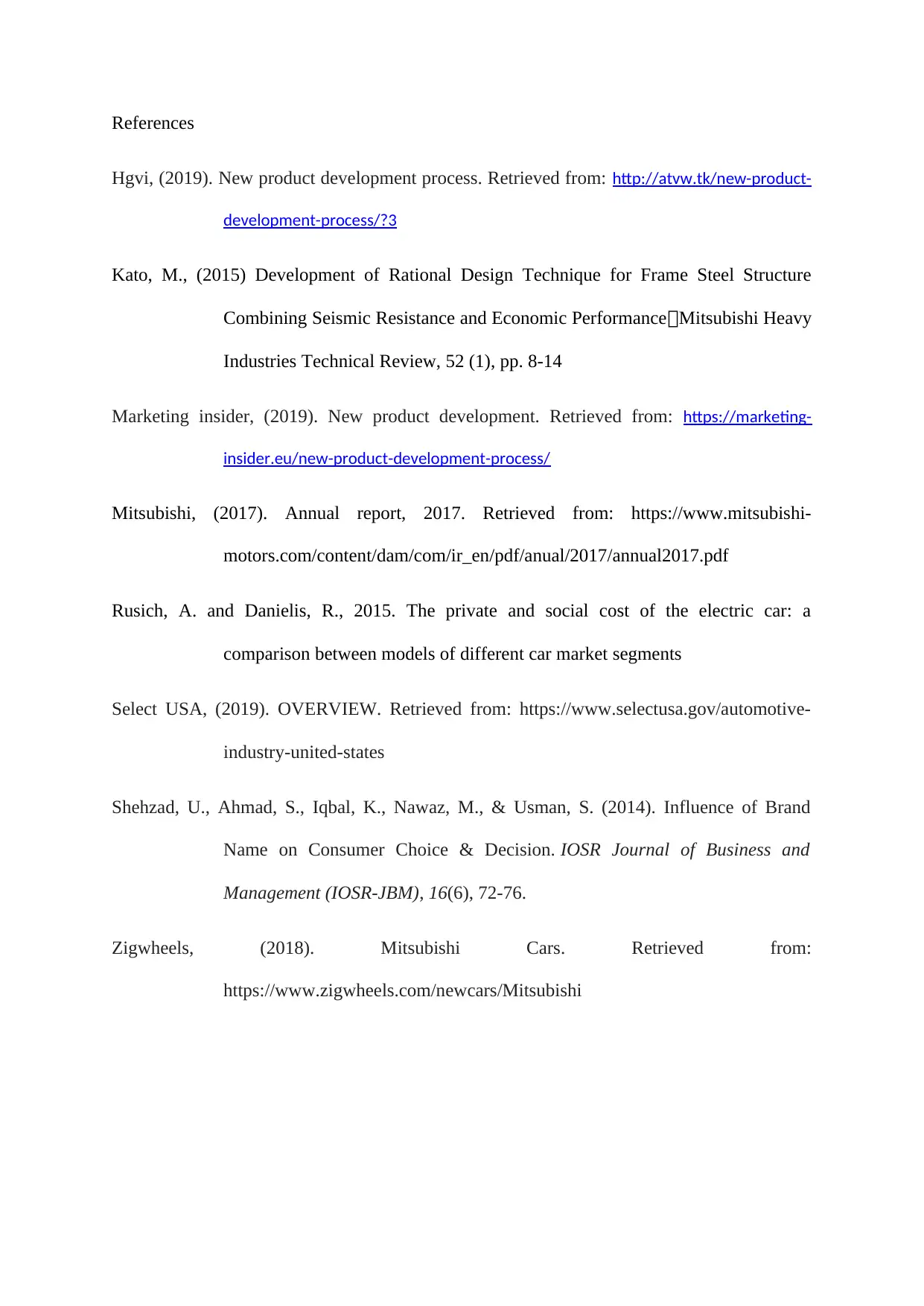
References
Hgvi, (2019). New product development process. Retrieved from: http://atvw.tk/new-product-
development-process/?3
Kato, M., (2015) Development of Rational Design Technique for Frame Steel Structure
Combining Seismic Resistance and Economic Performance,Mitsubishi Heavy
Industries Technical Review, 52 (1), pp. 8-14
Marketing insider, (2019). New product development. Retrieved from: https://marketing-
insider.eu/new-product-development-process/
Mitsubishi, (2017). Annual report, 2017. Retrieved from: https://www.mitsubishi-
motors.com/content/dam/com/ir_en/pdf/anual/2017/annual2017.pdf
Rusich, A. and Danielis, R., 2015. The private and social cost of the electric car: a
comparison between models of different car market segments
Select USA, (2019). OVERVIEW. Retrieved from: https://www.selectusa.gov/automotive-
industry-united-states
Shehzad, U., Ahmad, S., Iqbal, K., Nawaz, M., & Usman, S. (2014). Influence of Brand
Name on Consumer Choice & Decision. IOSR Journal of Business and
Management (IOSR-JBM), 16(6), 72-76.
Zigwheels, (2018). Mitsubishi Cars. Retrieved from:
https://www.zigwheels.com/newcars/Mitsubishi
Hgvi, (2019). New product development process. Retrieved from: http://atvw.tk/new-product-
development-process/?3
Kato, M., (2015) Development of Rational Design Technique for Frame Steel Structure
Combining Seismic Resistance and Economic Performance,Mitsubishi Heavy
Industries Technical Review, 52 (1), pp. 8-14
Marketing insider, (2019). New product development. Retrieved from: https://marketing-
insider.eu/new-product-development-process/
Mitsubishi, (2017). Annual report, 2017. Retrieved from: https://www.mitsubishi-
motors.com/content/dam/com/ir_en/pdf/anual/2017/annual2017.pdf
Rusich, A. and Danielis, R., 2015. The private and social cost of the electric car: a
comparison between models of different car market segments
Select USA, (2019). OVERVIEW. Retrieved from: https://www.selectusa.gov/automotive-
industry-united-states
Shehzad, U., Ahmad, S., Iqbal, K., Nawaz, M., & Usman, S. (2014). Influence of Brand
Name on Consumer Choice & Decision. IOSR Journal of Business and
Management (IOSR-JBM), 16(6), 72-76.
Zigwheels, (2018). Mitsubishi Cars. Retrieved from:
https://www.zigwheels.com/newcars/Mitsubishi
1 out of 7
Related Documents
Your All-in-One AI-Powered Toolkit for Academic Success.
+13062052269
info@desklib.com
Available 24*7 on WhatsApp / Email
![[object Object]](/_next/static/media/star-bottom.7253800d.svg)
Unlock your academic potential
Copyright © 2020–2025 A2Z Services. All Rights Reserved. Developed and managed by ZUCOL.





